U.S. Department of Transportation
Federal Highway Administration
1200 New Jersey Avenue, SE
Washington, DC 20590
202-366-4000
| < Previous | Table of Content | Next > |
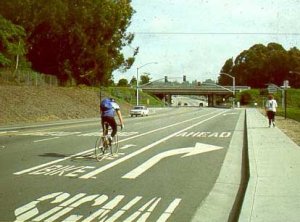 While
bike lanes are desired in many urban locations, designers face the reality
that most urban streets are surrounded by built-up environments, and are already
constrained by large volumes of automobile traffic. Finding the extra width
for bike lanes is often very difficult in retrofit situations, unless plans
call for a roadway widening project. For downtown central business districts,
roadway widening for bike lanes is not usually a desired option, since it
could cause problems for pedestrians by further reducing sidewalk space.
While
bike lanes are desired in many urban locations, designers face the reality
that most urban streets are surrounded by built-up environments, and are already
constrained by large volumes of automobile traffic. Finding the extra width
for bike lanes is often very difficult in retrofit situations, unless plans
call for a roadway widening project. For downtown central business districts,
roadway widening for bike lanes is not usually a desired option, since it
could cause problems for pedestrians by further reducing sidewalk space.
Retrofitting urban streets to include bike lanes has become a new area of study, and several States and local governments have developed innovative solutions. This lesson includes excerpts from the 1995 Oregon Bicycle and Pedestrian Plan, as well as an article published in the Pro Bike/Pro Walk '96 Conference Proceedings by Chuck Fisher, the Bicycle/ Pedestrian Planner for the City of Salem, Oregon.
To accommodate bicyclists on busy roadways in urban areas, bike lanes generally serve bicyclists and motorists best.
Many roadways in urban areas were originally built without bike lanes. These roadways often act as deterrents to bicycle travel and may cause conflicts between bicyclists and motorists. The needs of cyclists can be accommodated by retrofitting bike lanes onto many existing urban roadways using the following methods:
Method #1 is simple, and bike lane marking standards are outlined in Lesson 19. Method #2 involves reconstruction (standards also outlined in Lesson 19). In many instances, existing curb-to-curb width allows only Method #3 to be considered.
Where existing width doesn't allow full standards to be used, it may be possible to modify portions of the roadway to accommodate bike lanes. Most States use the following standards: 4.2-meter (14- foot) center turn lanes, 3.6-meter (12-foot) travel lanes, 1.8-meter (6-foot) bike lanes, and 2.4-meter (8- foot) parking lanes. These guidelines should be used to determine how the roadway can be modified to accommodate bike lanes without significantly affecting the safety or operation of the roadway. Reduced travel-lane widths are within AASHTO minimums. It is important to use good judgment, and each project should be reviewed by a traffic engineer.
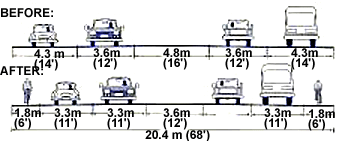
Reduced travel-lane widths.
The need for full-width travel lanes decreases with speed:
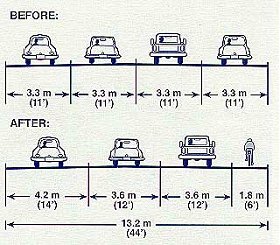
Travel lanes reduced from four to three on a one-way street.
Many one-way couplets were originally two-way streets. This can result in an excessive number of travel lanes in one direction. A study will determine if traffic can be handled with one less lane. On two-way streets with four travel lanes and a significant number of left-turn movements, restriping for a center turn lane, two travel lanes, and two bike lanes can often improve traffic flow.
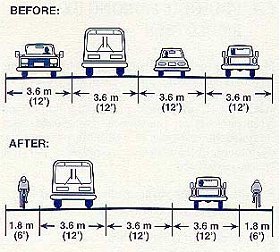
Travel lanes reduced from four to two, with center turn lane.
A roadway's primary function is to move people and goods rather than to store stationary vehicles. When parking is removed, safety and capacity are generally improved. Removal of parking will require negotiations with the local governing body (such as the city council), affected business owners, and residents.
To stave off potential conflicts, careful research is needed before making a proposal, including:
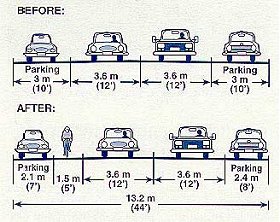
Narrowing parking on a one-way street.
Rather than removal of all on-street parking, several other options can be pursued:
Parking can be narrowed to 2.1 meters (7 feet), particularly in areas with low truck parking volumes, since today's cars are smaller.
In some cases, parking may be needed on only one side to accommodate residences and/or businesses.
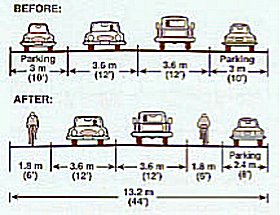
Parking removed on one side of a two-way street.
Note: It is not always necessary to retain parking on the same side of the road through an entire corridor.
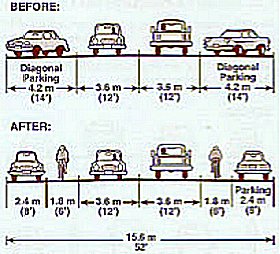
Changing from diagonal to parallel parking on a two-way street.
Diagonal parking takes up an inordinate amount of roadway width relative to the number of parking spaces provided. It can also be hazardous, as drivers backing out cannot see oncoming traffic. Changing to parallel parking reduces availability by less than one-half. Special Note: On one-way streets, changing to parallel parking on one side only is sufficient; this reduces parking by less than one-fourth.
Most business owners cite the fear of losing potential customers as the main reason to retain onstreet parking. Many cities have had success with ordinances prohibiting employees from parking on the street. This could help increase the number of available parking spaces for customers, even if the total number of parking spaces is reduced. Special Note: One parking place occupied by an employee for 8 hours is the equivalent of 16 customers parking for half an hour, or 32 customers parking for 15 minutes.
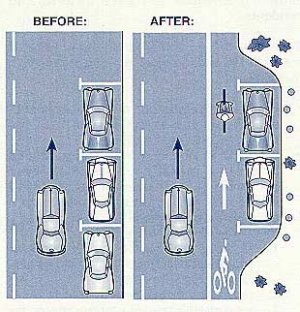
Providing parking when there are no reasonable alternatives.
Where all of the above possibilities of replacing parking with bike lanes have been pursued, and residential or business parking losses cannot be sustained, innovative ideas should be considered to provide parking, such as with off-street parking. Other uses of the right of way should also be considered, such as using a portion of a planting strip, where available.
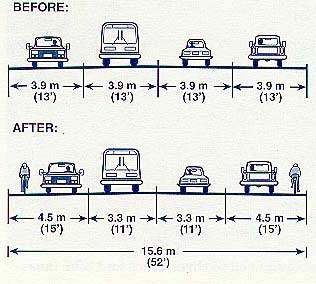
Restriping for wide curb lane.
Not all existing roadway conditions will be as simple to retrofit as those listed previously. In many instances, unique and creative solutions will have to be found. Width restrictions may only allow for a wide curb lane (4.2 to 4.8 meters [14 to 16 feet]) to accommodate bicycles and motor vehicles.
Bike lanes must resume where the restriction ends. It is important that every effort be made to ensure bike lane continuity. Practices such as directing bicyclists onto sidewalks or other streets for short distances should be avoided, as they may introduce unsafe conditions.
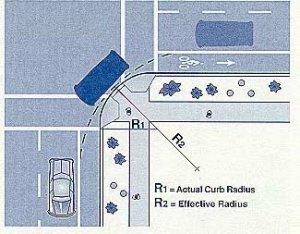
An effective radius at intersections is increased with bike lanes.
Other minor improvements at the outer edge of the roadway should be made in conjunction with bike lane restriping, including:
Safety is enhanced as travel lanes are offset from curbs, lanes are better defined, and parking is removed or reduced. Adding bike lanes can often improve sight distance and increase turning radii at intersections and driveways.
Restriping travel lanes moves motor vehicle traffic over, which can help extend the pavement life, as traffic is no longer driving in the same well-worn ruts.
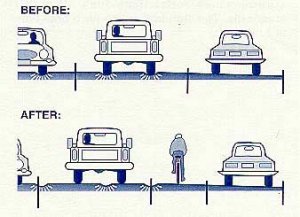
Motor vehicles no longer drive in wheel ruts after restriping.
While it is important to maintain standards for bicycle facilities, there may be circumstances where restrictions don't allow full standards. The standard width for a bike lane is 1.8 meter (6 feet).
Minimum widths are:
Retrofitting bike lanes into a city's built environment is perhaps a bicycle coordinator's most difficult challenge. This is especially true when the removal of existing on-street parking is involved. Some would cry that street space is not for the storage of vehicles and should instead accommodate only moving traffic. However, if as planners we are promoting in-fill and neotraditional development that is designed to encourage people to work and shop near their homes, we cannot at the same time remove on-street parking from older neighborhoods that have no alternatives. If we do, it is likely that the mom-and-pop store on the corner will close, and neighbors will be forced to jump in their cars to grab a quart of milk.
The first step in the evolution of this process was identifying which streets would make the best connections for bicyclists. Not unlike directions from a down-east farmer, Salem's (Oregon) bikeway system has long been characterized as "you can't get there from here." This is due primarily to the lack of connectivity between the outer areas' bicycle facilities and the downtown core. Particularly lacking are connecting bicycle lanes within 2 miles of downtown, the area most likely served by increased bicycle ridership.
Retrofitting these older neighborhoods with bike lanes and removing all on-street parking would probably have created a political firestorm. Recognizing this, the City of Salem staff developed policies and methodologies that allowed for the mitigation of on-street parking demand.
The policy language is contained within the Goal, Objective, and Policies of the Salem Transportation System Plan's Bicycle System Element:
Policy 1.2 – Mitigation of On-Street Parking Loss Due to Future Bicycle Facility Projects.
Where new bicycle facilities require the removal of on-street parking spaces on existing roadways, parking facilities shall be provided that mitigate, at a minimum, the existing on-street parking demand lost to the bike project. This policy does not apply to street widening or major reconstruction projects.
The key phrase in the policy is the mitigation of parking demand, not supply. As part of the update of the Transportation Plan, the staff developed criteria for ranking potential bike projects. Working with this list, the staff determined which projects were to be included for the next construction/striping season. A process was then put into motion that included many of the criteria developed by the City of Portland.
First and foremost, the staff surveys the existing onstreet parking demand on the facility. Other data collection includes existing cross-sections and onstreet parking supply. Analysis activities included sketching cross-section design, locating alternative on-street parking locations, and initial project cost estimates.
At this point, the staff begins a public involvement process that includes neighborhood meetings, letters to abutting property owners, public workshops to determine alternatives, on-street sign notification, Citizens Advisory Traffic Commission meetings, and final approval by the City Council.
Some of the alternatives presented by the staff at the meeting workshops include restriping the road to accommodate parking on one side versus two. Neighbors are asked to help determine on which side of the street parking should remain, given that only half the parking supply is required to meet the demand. A variation on this is alternating the parking from side to side. For instance, if a six-block area requires parking on one side, a solution might be to allow parking on one side for three blocks then alternating to the other side for three blocks.
Another alternative, especially if there is only a small amount of parking mitigation required, for say, that mom-and-pop store, is to build parking bays. Similar to bus pull-outs, these add the necessary room to accommodate parking in what was the planting strip, between the curb and sidewalk.
Choose a local urban street that would be a good candidate for a bike lane retrofit project. Redesign a two-block section of the roadway to include bike lanes (sketch drawings will be sufficient). Present at least two options for retrofitting the street, and include solutions that would require further traffic studies. Indicate proposed dimensions for travel lanes, parking lanes, and bike lanes. If removal of parking is one of your solutions, describe the public involvement process you would go through to achieve agreement from adjacent property owners and businesses.
Text and graphics for this section were derived from:
Oregon Department of Transportation, Oregon Bicycle and Pedestrian Plan, 1995.
Chuck Fisher, "Retrofitting Bicycle Lanes While Mitigating On-Street Parking Demand," Pro Bike/Pro Walk 1996 Conference Proceedings.
For more information on this topic, refer to:
AASHTO, Guide for the Development of Bicycle Facilities, 1999
| < Previous | Table of Content | Next > |
